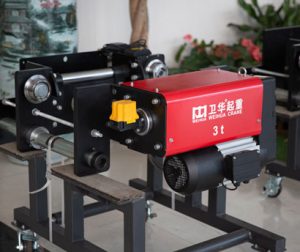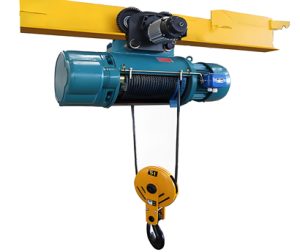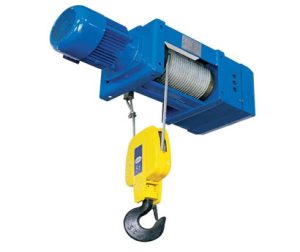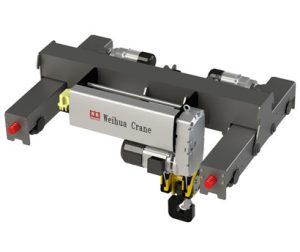
산업 현장에서 들어 올리거나 당기는 작업을 할 때, 광고, 아니면 집 설정이라도, 전기 윈치와 전기 호이스트는 종종 혼동을 일으키는 두 가지 일반적인 도구입니다.. 유사해 보일 수도 있고 때로는 구성 요소를 공유할 수도 있지만, 그들의 목적, 메커니즘, 안전 기준이 크게 다릅니다. 귀하의 응용 분야에 적합한 장비를 선택하려면 이러한 차이점을 이해하는 것이 필수적입니다..
온라인 채팅전기 윈치 호이스트: 안 전기 윈치 호이스트 주로 무거운 짐을 수평으로 당기도록 설계되었습니다.. 오프로드 차량에 일반적으로 사용됩니다., 건설 현장, 해양 작전, 장비 및 재료를 끌거나 재배치하기 위한 워크샵.
전기 호이스트: 전기 호이스트는 하중을 수직으로 들어 올리고 내리도록 설계되었습니다.. 일반적으로 공장에서 사용됩니다., 창고, 중장비를 올리기 위한 생산라인과, 도구, 또는 팔레트를 안전하고 효율적으로.

윈치: 수평 이동에 가장 적합. 중력 하중에 맞게 설계된 제동 시스템이 없기 때문에 수직 리프팅에 사용하는 것은 위험할 수 있습니다..
감아 올리기: 수직 리프팅용으로 설계됨. 하중 낙하를 방지하기 위해 견고한 제동 메커니즘이 내장되어 있습니다..
전기 윈치: 표준 윈치에는 안전 장치 로드 브레이크가 포함되지 않을 수 있습니다.. 시간이 지나도 공중에 매달린 하중을 안전하게 고정할 수 있는 장비가 없습니다., 리프팅에 부적합하게 만듭니다..
전기 호이스트: 호이스트에는 부하를 즉시 멈추고 제자리에 고정할 수 있는 기계식 또는 전자기식 브레이크가 함께 제공됩니다., 정전 중에도 최적의 안전 보장.
윈치 당기는 힘을 최대화하기 위해 유성 기어가 있는 고속 모터를 사용하는 경우가 많습니다..
호이스트 저속에서 정밀한 제어와 높은 토크를 제공하도록 설계된 모터 및 기어 세트 기능, 원활한 리프팅 및 하강 보장.

전기 윈치 당기는 힘으로 평가됩니다, 일반적으로 파운드로 측정됩니다. (파운드) 또는 킬로뉴턴 (kN).
전기 호이스트 리프팅 용량 등급이 지정되어 있습니다., 킬로그램으로 측정 (kg) 또는 톤, 산업 안전 표준을 엄격히 준수합니다..
| 애플리케이션 | 윈치를 사용하세요 | 호이스트를 사용하세요 |
| 차량 끌기 | √ | × |
| 메자닌으로 장비 리프팅 | × | √ |
| 지상에 있는 통나무 위치 변경 | √ | × |
| 트럭에 중장비 싣기 | × | √ |

기술적으로, 윈치는 때때로 가벼운 하중을 수직으로 들어올릴 수 있습니다., 하지만 안전 문제로 인해 권장되지 않습니다.. 당기기 위해 호이스트를 사용하면 내부 구성 요소가 손상될 수도 있습니다.. 항상 각 장치를 의도된 목적에 맞게 사용하십시오..
전기 윈치와 전기 호이스트는 비슷해 보이지만, 기능면에서 그 차이가 상당합니다., 안전, 성능. 수평으로 당겨야 하는 경우, 전기 윈치로 가세요. 수직으로 들어 올려야 하는 경우, 항상 하나를 선택하세요 전기 호이스트. 이러한 차이점을 이해하면 작업을 올바르게 완료할 수 있을 뿐만 아니라 안전하게 작업을 수행할 수 있습니다..
우리는 귀하의 의견을 소중히 여깁니다! 귀하의 특정 요구에 맞게 서비스를 조정할 수 있도록 아래 양식을 작성하십시오..

빠른 속도로, 현대 창고의 까다로운 환경, 능률, 안전, 그리고 ……

오버 헤드 전기 와이어 로프 호이스트는 리프팅 기술의 정점을 나타냅니다., ……

12 톤 체인 호이스트는 단순한 도구가 아니라 다운 타임에 대한 최전선 방어입니다., 안전한……

전기 호이스트 트롤리 어셈블리는 매달리고 ……
